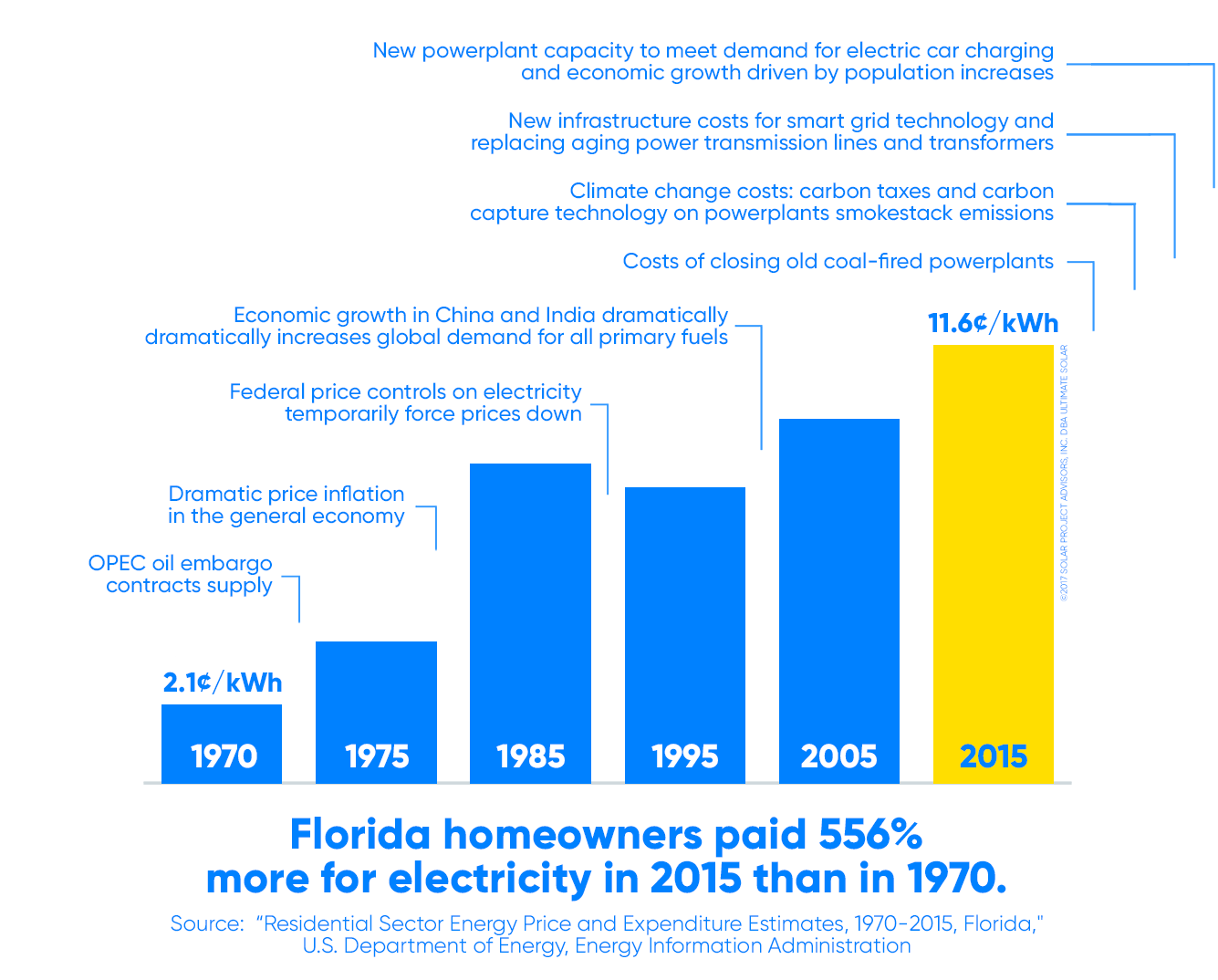We believe electric vehicle charging will greatly increase the demand for electricity over the next 20 years. How big will the increase be? Well, just consider residential electric car charging. Electric cars average about 3 miles per kilowatt-hour. So, for a family of three living in a 2,400 square foot Florida house built to current energy efficiency standards, one electric car driven 13,500 miles per year will increase household electricity consumption by 23%. Two electric cars, each driven the same 13,500 miles per year, would increase the household’s electricity consumption by about 47%. But… no gas bills! 1
Predicting the Future Cost of Electricity
We believe the cost of electricity sold by utility companies will increase faster in the future than it has in the past.
We do our best to provide reasonable guidance about the future direction of utility electric rates. Naturally, no one can predict the future. You should understand that even though the cost of utility generated electricity is virtually certain to increase dramatically over the next 20–30 years, it is possible that costs may not increase as fast, in the near term, as you or we expect.
It is also possible that electricity costs may remain relatively unchanged, or even decline from one year to the next, in some years. But the long-term trend has always been and will likely continue to be higher energy prices.
Why Energy Costs Keep Going Up
If you have a mutual fund or other financial investments, you’re probably familiar with the phrase, “Past performance does not necessarily predict future results.” But when it comes to energy costs, there is a lot less uncertainty than we face with things like the stock market. Why is this?
It’s primarily because we get most of our electricity by burning oil, coal and natural gas, all commodities that have relatively well understood supply and demand. Over the past 45 years, basic supply and demand have had by far the biggest impact on the cost of electricity. Major oil producing nations like Saudi Arabia, Iran and Venezuela drove energy prices up by limiting production. And while new technologies like shale oil and gas production have made new, harder to recover oil and gas reserves economical, oil and gas nevertheless remain finite resources.
In the last 20 years, energy demand from rapidly modernizing countries like China, India and Brazil has far outstripped any increases in supply from discovery of new fossil fuel reserves. When demand increases faster than supply, prices go up.
This is why we believe the 4% average yearly rate of increase in U.S. residential electricity costs since 1970 is just a floor for the actual cost increases we should probably expect in the coming years. We believe the average yearly rate of increase for the next 20–30 years will be greater than 4%. How much greater is anybody’s guess.

Why Future Increases Will Probably Be Greater
Modernization in emerging market countries—increasing global demand more than supply—will not be the only cause of energy cost increases in the future. Other causes of new, added pressure on utility generated electricity costs will likely include:
- increased electric utility infrastructure spending for:
- replacement of aging power transmission and distribution assets
- hardening the national electric power grid against cyber terrorism threats
- new generation capacity to meet growing demand from electric vehicle charging
- new carbon capture technology for powerplant smokestacks
- recovery of utility company “stranded costs” when closing coal-fired and other powerplants that are no longer cost competitive in a clean energy regulatory and business environment
- carbon taxes on powerplant smokestack emissions
As a result of all these added pressures, we think it is completely reasonable to believe that future rates of increase in electricity costs will exceed historical rates. And probably not by a small amount.
The Key Point to Understand
Historical supply and demand pressures on fossil fuel costs are not going away and may get worse over time. So new climate change and technology cost pressures will be added to historical cost pressures.
What About Energy Technology Breakthroughs?
The future will certainly hold surprises. Probably even some pleasant ones. But as the distinguished historian of energy technology, Vaclav Smil, has noted, each radical innovation in civilization’s energy technology has taken about 50 years to achieve widespread adoption. So if some radical energy technology breakthrough occurs tomorrow, history suggests that it will take about half a century before an adequate infrastructure can be put into place to exploit the new technology.2
In other words, a radical breakthrough in energy technology today isn’t likely to impact utility electric rates for several decades. We see this technology adoption pattern with today’s widespread commercialization of solar photovoltaic power, a technology first demonstrated in 1954.
Get Some Energy Uncertainty Insurance
Electric utility companies pass along all of their costs to customers. No one can say with certainty what will happen to the cost of electricity in the coming years. But one thing we do know is that owning a rooftop solar power system can freeze your cost of energy for most, if not all, of your electricity consumption. And the sooner you get started, the more you’ll save.